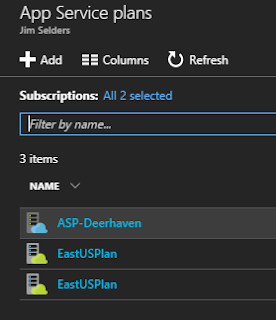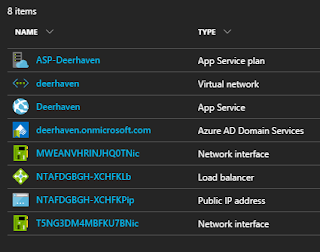In the Azure cloud environment, many computing resources and
asset types can be created to build-up an operational environment to support
business needs. These include computers, networks, databases, queues, IP
addresses, etc. All Azure resources have one thing in common – they must be
given a name when being created. It’s a very good idea to develop a naming
convention for resources prior to
creating them.
Why Naming Conventions?
For anyone who’s worked with computers, and especially for
those who write software, naming conventions are a well-known topic and best practice.
A good naming convention – using abbreviations or upper/lower case for example
– can improve maintainability, reduce human errors, and lower training
complexity. The reason is rather simple, actually – the name assists in
identifying the intended use of something, and possibly a categorization. For
example, a SQL Server storage procedure might be called sp_Calculate_Salestax, where “sp” indicates that the object is a
stored procedure (useful when seeing a long list of items; it’ll also cause
like items to sort together in a display), and it performs a sales tax
calculation. Without ever seeing the source code or having to reverse-analyze
it, one can discern what the object is, and what it does. The underscores and
initial capitalization make the name easier to read quickly.
A significant factor in Azure resource naming is that once a
name is chosen at creation-time, it cannot
be changed. The closest approximation of changing a name is to create an
identical new resource with the preferred name, then delete the old one. That’s
fine if you’ve just created the resource, but if you’ve got 100 of them and
they’re interlinked, it’s essentially impossible. You’re stuck with the “wrong”
name indefinitely. That’s why adopting a convention before creating resources is a really, really good idea.
Azure Silly Naming
Azure’s a bit funny when it comes to names, however. Some
resource names can include punctuation, some can include mixed-case, and others
cannot. There doesn’t seem to be any rhyme or reason – it’s really up to the
specific resource being created. Therefore, it’s impossible to create one
naming convention and use it consistently throughout Azure. Name length limits
are also variable, dependent upon resource type, from 24 to 1024 characters. Microsoft’s
documentation shows 23 different naming rules for the various Azure resources
(see link, below), and you can expect this list to grow as new services are
added.
One factor that influences allowable name syntax is
whether the resource is internet-facing with a DNS name, or not. The internet’s
naming rules have been around a long time and are very set, so it’s reasonable
that internet-facing resources must comply with DNS naming requirements. Azure takes
this a little further, disallowing some valid DNS syntaxes in certain contexts.
The following image shows a valid internet DNS name (jimmy-azure.core.windows.net) being
rejected by Azure for a storage account.
 |
| DNS name rejection by Azure |
But here’s a similar name, accepted for a Function App (jimmy-azure.azurewebsites.net).
 |
| DNS name acceptance by Azure |
Automatic Names
There’s also a resource naming oddity I’ll mention in particular. When creating a Function App and specifying the Consumption Plan, Azure will make a special version of an App Plan on your behalf (with a unique icon) and set the name based upon deployment region. In the East US datacenter, Consumption App Plans will all be named EastUSPlan, a duplicate name which you cannot change. You won’t be able to distinguish which plan goes with which Function App. Internally, the identifier for each App Plan is unique, so Azure won’t confuse them, but your administrator won’t easily be able to understand which is which, and specific associations to Function Apps.
Here are 2 Consumption App Plans with duplicate names,
created and named automatically during provisioning of a Function App.
 |
| Duplicate App Service Plan names |
In another example, provisioning an Azure AD Domain Service also caused the creation of a virtual network with associated NICs, address, and load balancer. Note the last 4 items' names - something Azure itself assigned, and which cannot be changed.
 |
| Azure-assigned resource names |
Tags
Resources also can have multiple tags associated with them. A tag is just a free-form short textual
name/value pair. This allows you to locate resources according to your tagging
strategy, regardless of the resource type or name. While not exactly a “name”,
tags are an alternative way to label and manage Azure resources, using whatever
tag-naming convention you wish and applicable across all Azure resources.
Here, a tag “applicationType
: web” is used to locate resources, which are show in the right blade.
 |
| Application tags |
Naming Best-Practice Suggestions
OK, taking into account the above peculiarities, what’s an
Azure architect or admin supposed to do when choosing a resource naming
convention? Are there any suggestions?
Sort-of. Microsoft has published an article with good details
on exactly this topic. They document the naming restrictions mentioned above, per
resource type. Azure resource names should be composites, formed segment-by-segment
from meaningful short strings.
Consider these name components to form a name. Use the minimum number of components to clearly
identify a resource within a larger Azure environment; avoid using redundant
components that don’t add identification value. Abbreviate name segments to 2
or 3 characters at most, to insure the final name won’t be too long. When
allowed, hyphenate the segments for easier reading. Consider excluding your
company’s organization names, since re-orgs can occur, and companies merge or
acquire other companies; thus this class of names is not necessarily durable.
- Company name (internet-facing only)
- Division name
- Resource location (East, West, etc.)
- Azure resource type (Storage, SQL, Virtual Machine, etc.)
- Technical function (Web server, DB server, domain controller, etc.)
- Serial / sequence
Naming Samples
Resource Name
|
Description
|
RG-Math
|
Resource group for math functions. Visible internally only, can
contain resources in multiple regions.
|
JA-AS-Math-Sqrt
|
App Service (web app) that provides a math function for square roots
for Jimmy Azure company. Region doesn’t matter. Name is visible on the internet
as http://as-math-sqrt.azurewebsites.net.
Using a company prefix is a good idea here, since this name must be globally
unique within azurewebsites.net.
|
ASP-Math
|
App Service Plan (PaaS VM scale unit) underlying the math app
service. Must be in same region as app service, but doesn’t matter which
region that is. Visible internally only.
|
VN-East-Sql
|
Virtual network in East region, intended to hold SQL Server. Network
isn’t directly visible on the internet; that’s the job of a public IP
address.
|
GW-East-Sql
|
Gateway attached to the virtual network for SQL in the East region.
|
JA-FN-Math-Sine
|
Function App for company Jimmy Azure, for a math function that
calculates Sines. Visible on the internet as https://ja-fn-math-sine.azurewebsites.net.
|
jasaeastsql01
|
Company Jimmy Azure, Storage Account intended for SQL Server in the
East region, number 01. Visible on the internet. Has more restrictive
character requirements. Accessible at jasaeastsql01.core.windows.net
and must be unique in core.windows.net.
|
JA-Srch-Docs01
|
Company Jimmy Azure, Search engine for documents, visible on the
internet at https://ja-srch-docs01.search.windows.net.
Region doesn’t matter.
|
References
- Microsoft general naming suggestions and restrictions.
- Microsoft Storage naming
- Microsoft Queue naming
- Microsoft Table naming
- Microsoft video starting with naming suggestions
Really I enjoy your blog with an effective and useful information. Very nice post with loads of information. Thanks for sharing with us..!!..Azure Online Training Hyderabad
ReplyDeleteNice Blog.
ReplyDeleteAzure Training in Chennai | Certification | Azure Online Training Course | Azure Training in Bangalore | Certification | Azure Online Training Course | Azure Training in Hyderabad | Certification | Azure Online Training Course | Azure Training in Pune | Certification | Azure Online Training Course | Azure Training | microsoft azure certification | Azure Online Training Course